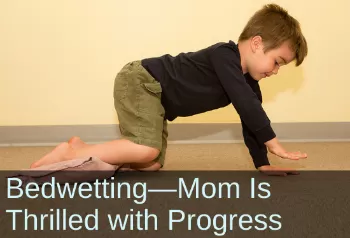Primitive Reflex Integration Case Studies
OT Learns Simple, Effective Tools to Help with Bedwetting for 7-Year-Old
Bedwetting greatly reduced after program of rhythmic movements and Spinal Galant reflex integration
This young boy experienced urinary accidents about every other day. His OT provided rhythmic movements and Spinal Galant reflex integration activities from the Brain and Sensory Foundations course, and now he only has an accident once per week at the most—sometimes even going a full week without one!
Submitted by Mary McKevitt, MS, OTR/L

| Before | After |
|---|---|
| Frequent urinary accidents; bedwetting several times a week | Bedwetting reduced to once per week or less |
| Poor fine and visual motor skills | Improved coordination, motor planning, and core strength |
Client is a 7-year-old child, who was diagnosed with Developmental Coordination Disorder. My client is currently receiving services due to difficulty sustaining attention and tendency to reverse letters when writing as well as other fine motor and visual motor concerns. Most recently, this client’s mother voiced concerns regarding frequent urinary accidents. Upon checking his Spinal Galant reflex, it is apparent he has an unintegrated Spinal Galant reflex.
I have used various tools from this [Brain and Sensory Foundations] course including: Rhythmic movements, Spinal Galant Reflex activities, playful development movements and core activation. As previously mentioned, my client struggles with attention and typically benefits from introducing novel games and services to facilitate participation in activities.
For his home program mom was educated on how to provide my client with Rhythmic Movement to provide him with relaxing input as he oftentimes has difficulty winding down. He also enjoyed one of the playful movement exercises to integrate Spinal Galant, which was recommended as homework. This exercise was not only great for his reflex integration, but also his coordination, motor planning and core strength. I saw significant improvements with utilization of these tools.
Upon initiation of rhythmic movements, my client immediately tensed up and resorted to flexion patterns to resist the movement. I considered taking a break but then requested for my client to sing along or pick a different song in order to give him more control within the situation. Once he started to sing, he slowly became more relaxed and allowed for me to move him more passively. He loved having rhythmic movements as part of our routine and would come to our sessions to different songs for each session that he wanted to “rock to”. We would then transition into doing one of our Spinal Galant Integration activities—he loved learning new ones. He was noted to have difficulty with active integration exercises such as the Playful Development Movements and would oftentimes get frustrated when he could not imitate my demonstrations initially. We would take Brain Tune up breaks as needed and return to tasks, which was very helpful. These activities were then recommended for homework in which his mother was great with carrying over. The biggest improvement his mother and I both noticed was with urinary accidents, as prior to this program he was experiencing urinary accidents approximately every other day. Now, he will experience an accident approximately 1x a week or less!
His mother has been thrilled with his progress and we have been completing these exercises for several weeks as I continue to as well within our sessions still consistently. Given that this was my first client to utilize reflex integration exercises with, I was hesitant to attempt multiple reflex integration exercises as once. I now plan on testing his ATNR [Asymmetrical Tonic Neck Reflex] to assist him with letter reversals.
I learned so much about the Spinal Galant reflex [from the Brain and Sensory Foundations course] with my client. So much to that I feel comfortable identifying possible needs for reflex integration work (especially Spinal Galant) with other clients similar to him on my caseload. I was unsure what to expect in terms of the integration work and how it might help with his accidents. As a practitioner, accidents are typically hard for me to alleviate with children. This is likely due to my approach in which I would attempt to work on accidents via interoception exercises and behavioral based strategies. I now know to be more mindful of the Spinal Galant reflex when given similar clients to this one.
(Edited, emphasis added)
*Disclaimer: The activities in the Brain and Sensory Foundations curriculum make use of the natural processes of neuroplasticity and development that are innately wired in the design of human beings to promote maturity and function. These activities appear to calm, organize, and mature the neuro-sensory-motor systems just as we see in the healthy development of human infants. Individual results may vary, and we do not claim to offer a diagnosis or cure for any specific condition or disorder. The Brain and Sensory Foundations activities appear to improve overall functioning resulting in measurable improvements for a range of conditions as demonstrated in over 1800 case studies from participants.

